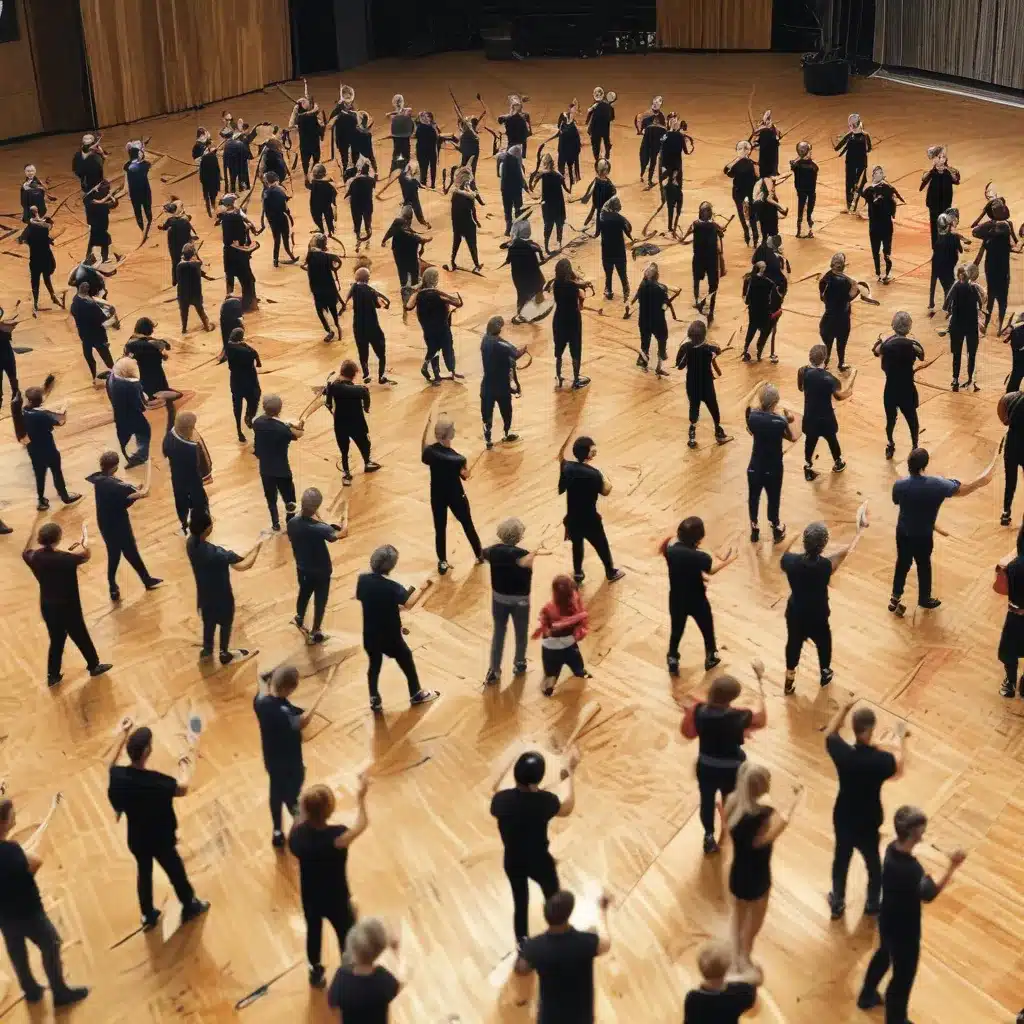
Herding Cats and Choreographing Chaos
As a theater educator, I’ve often found myself feeling like a ringmaster in a three-ring circus when it comes to rehearsing large ensemble numbers. It’s like trying to herd cats – the sheer number of moving parts, the varying skill levels, and the need to keep everyone engaged and coordinated can feel downright chaotic at times. But you know what they say, “out of chaos comes creation,” and that’s precisely the mindset I’ve learned to embrace when tackling these theatrical behemoths.
In my years of working with musical theater students, I’ve developed a toolbox of rehearsal techniques that have helped me transform the pandemonium of large ensemble numbers into something truly magical. From fostering collaboration and communication to incorporating physical and spatial awareness exercises, these strategies have allowed me to bring order to the chaos and empower my students to shine, both as individuals and as a cohesive unit.
Collaboration is Key
One of the key principles I’ve learned is that collaboration is essential when working with a large ensemble. As Maureen Brady Johnson, author and theater educator, so aptly put it, “theatre is a collaborative art, and they must learn to work with everyone.” I make a point to foster an environment where my students feel empowered to contribute ideas, experiment with different approaches, and support one another throughout the creative process.
Early on in the rehearsal process, I’ll often have the ensemble break into smaller groups to tackle specific choreographic challenges or character development. This not only encourages teamwork and communication, but it also allows the students to take ownership of their roles and feel invested in the overall success of the number. I’ll then have each group present their work to the larger ensemble, sparking a valuable exchange of feedback and ideas.
By nurturing this collaborative spirit, I’ve found that my students become more invested in the final product and are more willing to put in the hard work required to pull off a cohesive and compelling large ensemble number. After all, when everyone feels like they have a stake in the outcome, they’re much more likely to rise to the occasion.
Fostering Spatial Awareness
Another key element in choreographing chaos is helping my students develop a keen sense of spatial awareness. Large ensemble numbers often require intricate patterns, formations, and transitions, and if the performers aren’t mindful of their own positioning and the positioning of those around them, the whole thing can quickly descend into a hot mess.
To address this, I’ll incorporate exercises that challenge my students to be acutely aware of their surroundings and the movement of their fellow performers. One of my favorites is the “freeze dance” – I’ll have the ensemble move freely around the space, then call out “freeze!” and have them hold their position, taking note of where their peers are situated. This helps them develop a better understanding of the overall spatial landscape and how their individual movements impact the group.
I’ll also have the ensemble practice walking through their blocking and formations, paying close attention to the timing and spacing of each transition. By drilling these elements, my students become more confident in their ability to execute the choreography with precision, even as the complexity and energy of the number builds.
Embracing the Unexpected
Of course, no matter how much planning and preparation goes into rehearsing a large ensemble number, there’s always going to be an element of the unexpected. Whether it’s a missed cue, a wardrobe malfunction, or a student who’s having an off day, the ability to adapt and think on your feet is crucial.
That’s why I encourage my students to embrace the chaos and see it as an opportunity for creativity. As figure skating director Sheryl Franks notes, “organization is key, but the less chaos, the better.” I’ll often have them improvise their way through unexpected situations, challenging them to come up with innovative solutions on the fly.
This not only helps them develop quick thinking and problem-solving skills, but it also fosters a sense of resilience and confidence that can carry over into their performances. When they know they can rely on their instincts and each other to navigate the unexpected, my students are far more likely to tackle the challenges of a large ensemble number with enthusiasm and excitement.
Bringing it All Together
At the Musical Theater Center, we believe that large ensemble numbers are the heart and soul of the musical theater experience. They’re the moments where the energy, passion, and sheer talent of a company come together to create something truly electrifying.
But as any theater educator knows, choreographing these complex, high-energy numbers is no easy feat. It requires a delicate balance of collaboration, spatial awareness, and flexibility – not to mention a healthy dose of creativity and resilience.
Through my own experiences and the lessons I’ve learned from the incredible theater educators and performers I’ve had the privilege of working with, I’ve developed a repertoire of rehearsal techniques that have consistently helped me transform the chaos of large ensemble numbers into something truly extraordinary.
From fostering a collaborative spirit among my students to incorporating spatial awareness exercises and embracing the unexpected, these strategies have empowered my ensemble members to work together seamlessly, overcome challenges, and deliver performances that leave audiences absolutely riveted.
So, the next time you find yourself staring down the daunting task of choreographing a large ensemble number, remember – out of chaos comes creation. With the right tools and the right mindset, you can turn that pandemonium into pure magic.

